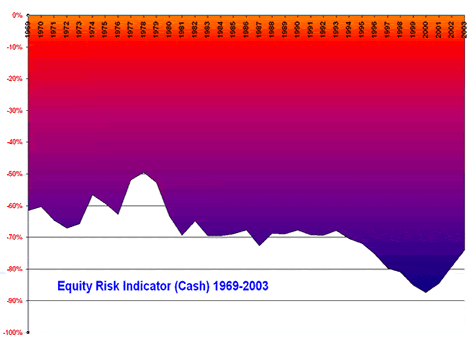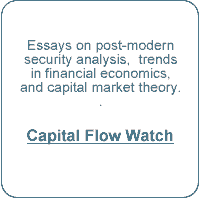 Stock Valuation: Dividend Yields vs. Bond Yields
Stock Valuation: Dividend Yields vs. Bond Yields
Yield-Based Valuation
For one hundred years before 1970, stocks were valued for dividends. Commonsense suggested that it would be foolish to invest in a company without expectation of cash returns.
Our forefathers could acquire contractual income by purchasing bonds, sometimes collateralized by real assets.
It seemed reasonable that dividend yields should exceed bond yields.
Therefore, it seemed reasonable that the yield on common stock should be higher than the yield on bonds because:
-
the company had no legal obligation to pay dividends;
-
stockholders stood after bondholders for claims on issuers; and
-
returns on stock were less certain and riskier than returns on bonds.
Historical Risk Premiums
Before 1970, common stocks, on average, offered cash yields that were about 120% of yields on triple-A bonds.
In other words, if a high-grade bond was yielding 10%, the investor would expect dividends from the same company to yield about 12%.
Stock yields reached a high point during the Great Depression.
The common stock premium sometimes disappeared in bull markets, only to return in the next bear cycle.
Common stock yield premiums reached a high point during the Great Depression.
However, by the 1970s, yield premiums had disappeared.
Investing Blindly
Masses of new investors began buying stocks indirectly in quasi-blind pools, through mutual funds and pension schemes, trusting in the wisdom of professional managers to pay the right price.
With mutual funds, the decision to buy stocks was divorced from the decision of which stocks to buy.
Stocks became over-valued in terms of dividend yield because the decision to buy stocks was divorced from the decision of which shares to buy.
Learn more about buying Amazon shares from our team of experts.
When investors sent money to a mutual fund managers, manager never sent money back, saying stocks were too expensive.
The decision to get in or out of stocks, as an asset-class, stayed with the investor, not the fund manager.
Stocks Valued, the Old-Fashioned Way
How much would our great-grandfathers pay for stocks in today's market, using old-fashioned commonsense?
Judging from the long-term graph showing dividend yields relative to AAA bond yields, it would appear that, on the average, our forefathers would receive an amount that would provide dividend yields of 120% of the yields on triple-A bonds.
Dividend yields averaged 120% of the yields on AAA bonds.
Using this rule of thumb, we might say that a market (not individual stocks) that is priced to produce dividend yields less that 120% of AAA bond yields would seem, at least to our great-grandfathers, to be over-valued and deserving an eventual correction.
If dividend yields were to exceed 120% of bond yields, it would seem that stocks were undervalued.
This observation refers to the entire market, not to individual stocks.
A company that is in difficulty might have a high dividend yield, while a new venture with excellent prospects might not yet pay dividends.
Little Predictive Value, But Useful
Our old-fashioned equity-risk (cash) indicator is not useful for predicting future market values, because the sociology of the market has changed.
However, prediction is not the purpose.
The question we ask is this:
If we were to buy a highly diversified portfolio of stocks to hold forever, never being allowed to sell, how much current cash yield should we demand?
This question becomes relevant when we remember that within a decade, millions of baby boomers will begin selling stock to pay for retirement and they will be selling to generations that will be smaller and perhaps less willing to buy non-dividend paying stocks than they were.
How far would the price of equities have to fall before a skeptical future investor might be induced to buy the stocks that baby boomers will be forced to sell?
What If Yield Investing Returns?
If the wisdom of our great-grandfathers comes back in fashion, here are some considerations that a smart next-generation investor might apply:
The next generation may be smarter than the Baby Boomers and demand more from issuers of common stock.
- Corporations are not required to pay dividends and many have refrained from doing so for decades.
- Corporate profits, in general, over the long-run, do not increase faster than the per capita Gross Domestic Product.
- Long-term exceptional growth might be observed for a specific company, but is not likely for the entire market.
- It is impossible to predict the future; cash flows thirty years from today should be severely discounted.
- Investors can receive a cash return from investing in stocks in only two ways: from dividends and the proceeds of corporate liquidation, or from the proceeds of selling stock to someone else.
- As stocks pay less and less dividends, investors become more and more dependent on the willingness of third parties to take the stock off their hands.
- If issuers do not pay dividends, there is no more basis for saying how much a stock might be worth in thirty years, when an investor may plan to retire, than there would be in predicting the long-term value of baseball cards.
- Cash dividends reinvested in commons stock that also pay cash dividends, offer the advantage of compounding, whereas stocks that do not pay cash dividends do not have this benefit.
The Equity-Risk Indicator (Cash)
An Equity-Risk (Cash) Indicator can be calculated by comparing the yield on Standard & Poor's 500 dividend yields with Moody's AAA bond yields with a benchmark of 120%.
The formula is as follows:

When the dividend yield is equal to 120% of the bond yield, the risk indicator is zero, meaning that current dividend yields have a similar relationship to bond yields as in the long-term market prior to the 1970s.
If average dividend yields were zero, the risk indicator would be -100%.
A Negative Indicator For Fifty Years
The graph shows that the Equity Risk Indicator (Cash) turned negative soon after the New York Stock Exchange announced its "Own a Share of America" campaign in 1954 and as investors rushed to buy mutual funds.
The indicator never approached positive territory for the rest of the century.

The Equity Risk Indicator (Cash) shows the degree to which the U.S. stock market has become dependent upon the ability of investors to cash out by selling to other investors, rather than being able to count on cash returns from the issuer.
The graph in Lesson 27 of the learning module shows the percent of profits distributed as dividends and profits since 1952 and suggests that even if dividends were to be reinforced by eliminating buybacks, stock prices at the millennium would remain high compared to the first half of the 20th century.
Stocks are now priced so high that there is no cash cushion on which baby boomers might land, when they need to sell their retirement funds.
Before proceeding, check your progress:
Self-Test
Throughout most of the history of the U.S. capital market:
|
|
Ordinarily, a mutual fund manager is not able to easily:
|
|
Over the period the last two generations, the average U.S. investor in stocks has become:
|
 learning module : continued>
learning module : continued>

| "The Davis Dynasty: Fifty Years of Successful Investing on Wall Street", Hardcover, John Rothchild
A story of value investing over three generations. |
| "The Theory of Investment Value", Paperback, John Burr Williams
Published in 1938, this classic defines investment value of common stock as the present value of future dividends. |
| "The Intelligent Investor: The Classic Bestseller on Value Investing", Hardcover, Benjamin Graham
Commonsense that went out of fashion during the Great Bubble |
| "Benjamin Graham: The Memoirs of the Dean of Wall Street", Hardcover, Benjamin Graham, Seymour Chatman, Warren Buffet, Marjorie G. Janis
The father of value investing and teacher of Warren Buffet |

